Paris has for decades been grappling with a housing shortage – leading to sky-high rent and property prices and an increasing numbers of locals being priced out of the city.
But a major part of the problem is the number of empty homes in the French capital – a study, published by the Atelier parisien d’urbanisme (APUR) found that 262,000 homes were not permanently lived in, making up 19 percent of Paris property.
And the number is rising, up from 14 percent in 2013.
In the last 10 years, the city – home to about 2.14 million people – has seen its total number of inhabitants drop by at least 120,000.
READ MORE: Why are so many people leaving Paris and is that ‘positive news’?
What is considered ‘unoccupied’ housing?
France’s national statistics body Insee considers unoccupied housing to be both “vacant” – homes that are empty either due to owners choosing not to live there or because it is in between owners or renters – and second homes.
Second homes are often defined as a place where people spend less than half of the year, but there are other factors.
READ MORE: Explained: Is your French property a main residence or a second home (and why it matters)?
Across France, around 10 percent of all properties are second homes.
In the French capital – unoccupied homes are roughly equally split between those that are used as second homes, and those that are simply empty – vacant homes made up 128,000 units as of 2020, (9.2 percent of the Paris real estate market) while there were 134,000 secondary residences (9.6 percent of the market).
The number of primary residences in the city has been falling for decades – in 1954, 98.3 percent of homes in the city were people’s primary residences, compared to 81.2 percent in 2020.

The study found that over the past few decades, the main driver for an increase in total unoccupied homes has been an increase in the proportion of second homes. Between 1975 and 2020, vacant properties went up by two percentage points, while the proportion of second homes rose by six percentage points.
As for the past decade, both vacant and second homes rose sharply in comparison to previous periods, representing a total increase of 72,000 properties.
The study found that if the trend from the past decade – specifically that between 2016-2019 – is to continue, then the city could lose up to 247,000 inhabitants and see 27 percent of homes unoccupied by 2040.
Why has there been an increase?
The study found that the increase in the unoccupied housing across Paris is at least partially linked to an increase in undeclared furnished tourist rentals.
READ MORE: What are the rules on renting out French property on Airbnb?
A 2018 French Senate report found that approximately 20,000 Paris flats were being diverted from the traditional rental market toward short-term platforms, like AirBnB.
Over the years, Paris has become an increasingly popular AirBnB destination – as of February 2023, there were over 55,000 ads for rental in the capital area. This represents more than New York (42,500 ads) and Barcelona (15,500 ads), making Paris a leading international city, behind London, for AirBnB listings.
However, there are strict rules for short-term rentals, and city authorities have increased crackdowns on those who do not respect rules, like failing to register your home.
Ian Brossat, the former deputy mayor in charge of housing (until October 2023), told Franceinfo that 10 years ago, judges typically handed out fines of around €500 to property owners who broke these rules – these days the average fine is €31,000.
He said that the increase in fines has “had a discouraging effect on property owners” from breaking the rules, and that regulations on short-term rentals and Airbnb have begun to bear fruit in the country’s capital.
Nevertheless, after the release of the study, Emmanuel Grégoire, the deputy mayor in charge of urban planning, told Le Parisien that “[the rise in unoccupied housing] is a phenomenon that needs to be curbed, because it’s helping to push people to the inner and outer suburbs, and it generates more commuting.
“There is enormous potential to be reclaimed [for the city].”
Some are calling for tax increases, like the current deputy mayor in charge of housing, Jacques Baudrier, who told Le Parisien that “the only solution is to increase taxation.” This would mean adding to the existing tax on vacant homes, as well as upping the surcharge on second homes.
READ MORE: The list of places in France charging extra property taxes from 2024
Baudrier said that his aim would be to increase the second homes surcharge from 60 percent to 300 percent, as well as requisitioning housing that has been vacant for more than two years.
Such proposals, however, would need to be passed by parliament before coming into effect.
Where are these unoccupied homes?
Overall, the majority were in central and western Paris. The 8th, 7th, 1st, and 6th arrondissements had the highest proportion of unoccupied homes, with 36 percent, 34 percent, 32 percent and 30 percent respectively.
The arrondissements with the lowest number tended to be on the edge of the city – like the 20th, 19th, 13th, and 12th arrondissements which had 9 percent, 13 percent, 14 percent, and 15 percent (respectively) of properties unoccupied.
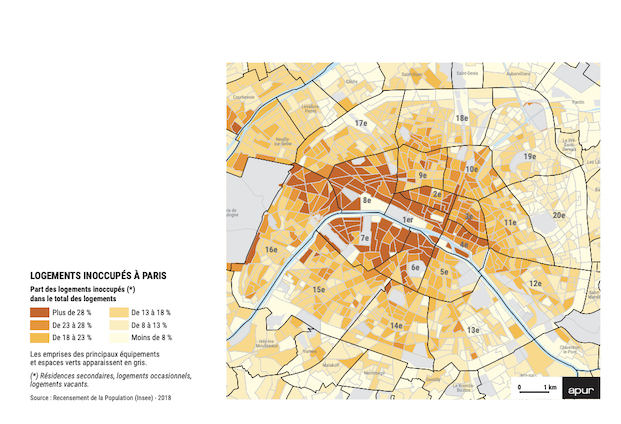
However, the picture is slightly different when breaking down based on second homes vs. vacant properties.
Second homes were primarily located in the centre and west, while vacant homes were slightly more evenly dispersed across the city.
North-eastern Paris has very few second homes – in comparison, researchers found that the 7th arrondissement had nine times the number of second homes than the 20th.
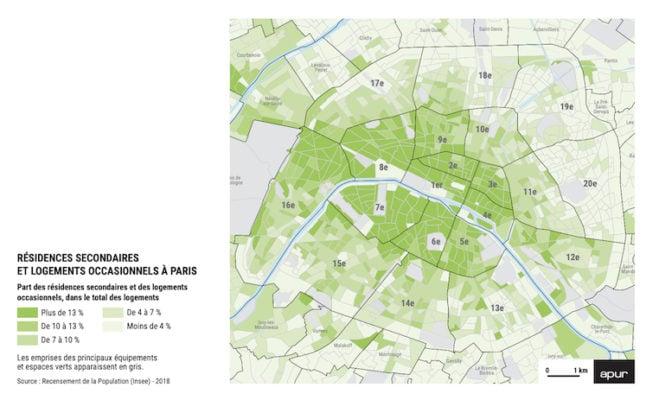
As for vacant properties, while the 10th and 8th arrondissements had the highest levels, with 16 percent and 13 percent of empty homes. After that, the central four arrondissements, the 11th and 14th all had vacancy rates between 10-12 percent, higher than the average of nine percent.
All other arrondissements, had vacancy rates between six to 10 percent.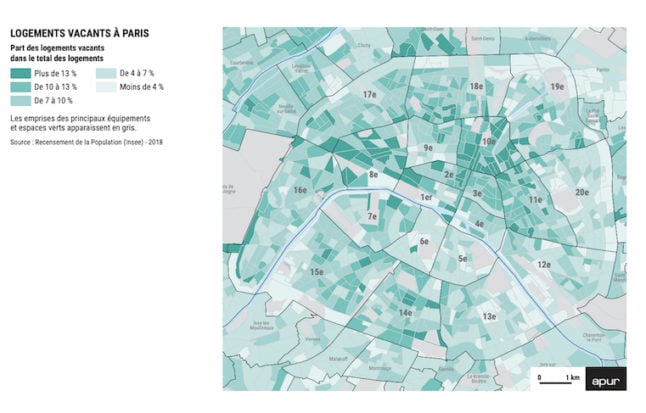
The data showed that the proportion of unoccupied homes per arrondissement was strongly correlated to residents’ income, as well as property prices. Affluent neighbourhoods especially attracted higher numbers of second homes.
The arrondissements with the highest price per square metre were also those with over 30 percent of homes’ unoccupied, as of 2020.
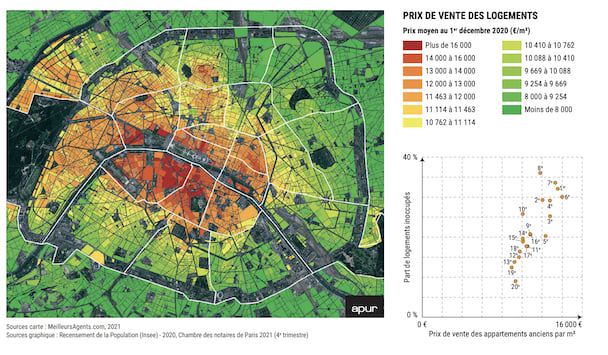
Similar trends occurred when looking at income levels – western and central arrondissements tended to be more wealthy and home to a higher number of vacant properties and second homes. In contrast, northern and eastern Paris home to higher proportions of low and medium income households, had fewer unoccupied properties.
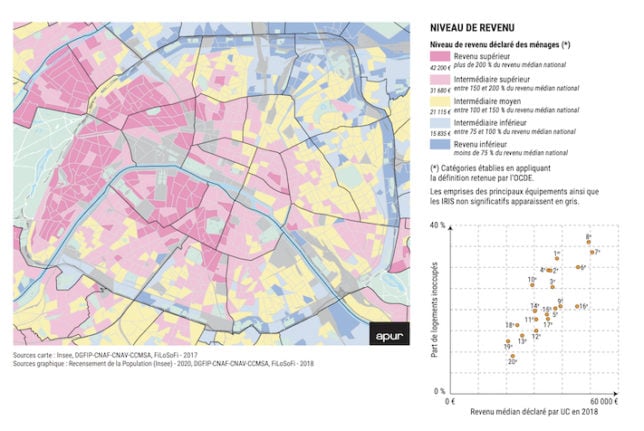
Who owns the unoccupied properties?
When looking at second homes, the majority (42.5 percent) of owners were from the Paris region, while another 38 percent lived in other parts of France.
Only 19.5 percent were foreigners – though this number also included French people living abroad.
Of those foreigners, the majority had properties in touristic districts like the 1st, 3rd, 4th, 6th and 7th arrondissements.
The leading foreign second home owners in Paris were from Italy, Switzerland, the UK and the US. Generally, most foreigners (60 percent) who owned a second home in Paris were European.

As for vacant properties – there are two types: short-term vacancies (eg a rental property that is between tenants) and long-term vacancies.
Long-term vacancies might be due to a number of factors, like the housing being unfit for habitation or undergoing extensive works. In some cases, they are kept vacant intentionally – a family might be waiting to move a certain person into the space, or there may be an investment strategy involved.
Overall, the majority (59 percent) of vacant properties are smaller than 40 square metres in size, and most are either studios or one-bedrooms.

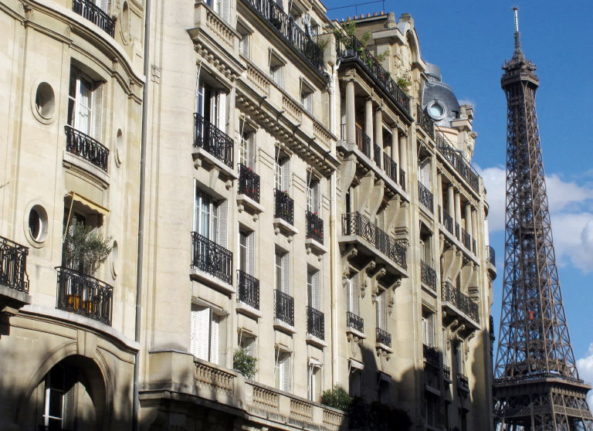

 Please whitelist us to continue reading.
Please whitelist us to continue reading.
Member comments